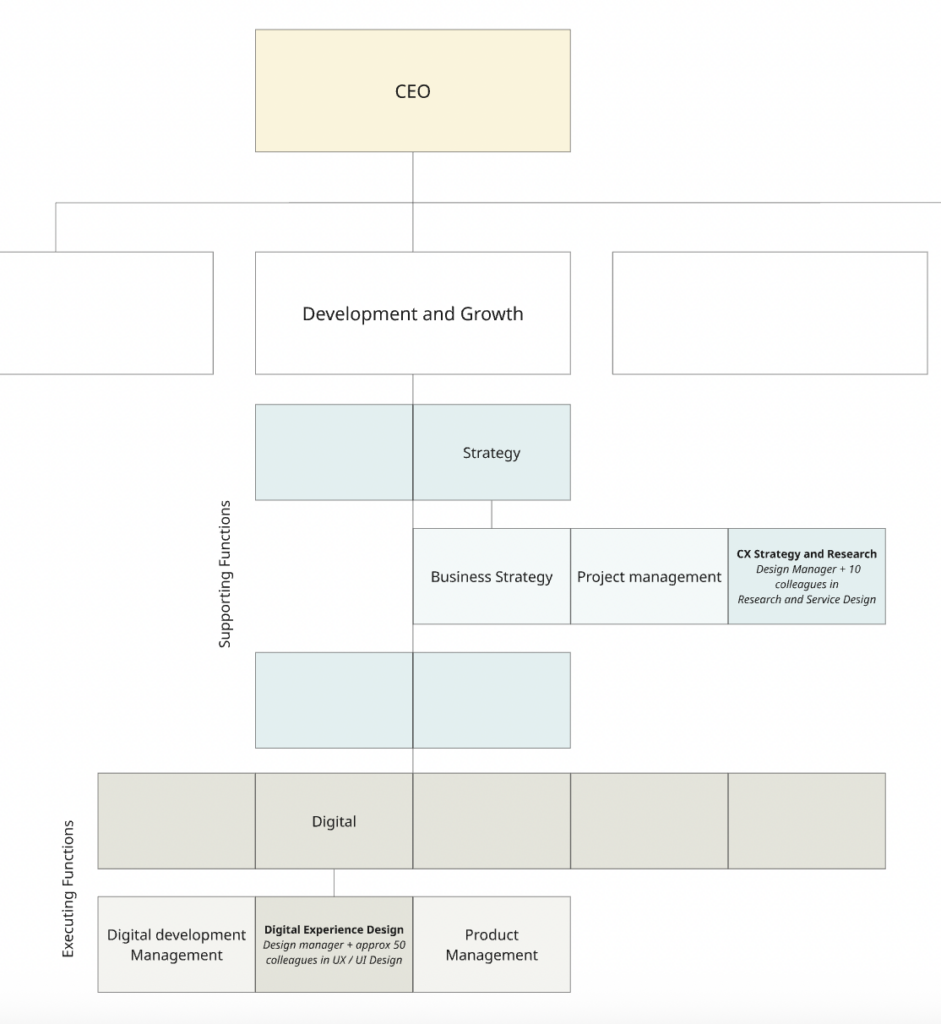
Design at H&M
H&M has three design teams working within Business and Digital Development, each organized by specialized expertise and function. Designers contribute as Internal Consultants in projects, aligned with business priorities.
Sofie Gillstedt is leading the CX team, responsible for bringing forth the customer & user perspective in everything.
- Service Design (6 people)
- User Research (3 people)
- Communication Design (1 person)

UX Design Teams
Embedded within product teams focusing on web and app experiences, working closely with developers and product owners.
Design Operations Team
Manages the design system and supports consistency, scalability, and efficiency across all design efforts.
Design Skill Sets
At H&M, there are seven core design skill areas identified that can be practiced at various levels without conflict or overlap. These areas allow for specialization while also enabling collaboration across different domains.
Designers are also encouraged to identify and develop their own unique skill sets, which may stem from their education, previous experience, or personal strengths. These may complement or extend beyond the core seven areas.
Facilitation is not listed as one of the seven skill sets, as it is considered a cross-cutting capability that supports all areas of design. Facilitation as H&M is regarded as a specific skill that requires practice and intention.
In Talks with Sophie Gillstedt

H&M’s journey with Service Design highlights the importance of creating an environment where design can make a real impact. Successfully introducing Service Design into an organization often hinges on one key factor: opening the first door. For H&M, this meant identifying challenges that required a holistic perspective—issues that weren’t isolated incidents but part of a broader journey. Service Design provided a way to connect individual experiences to larger organizational goals, and leadership played a critical role in embedding it into the company’s culture and business strategy.
“The first step was helping the organization understand that certain challenges aren’t just isolated incidents but part of a broader journey. We showed them how Service Design could bridge these gaps and create meaningful, sustainable change.”
Integrating Service Design into an organization isn’t just about adopting a new way of thinking—it’s about shifting mindsets and challenging the status quo. For Service Designers to succeed, they need an environment built on trust, where leaders support and advocate for their work. When designers know their leaders have their back, they can drive real change.
“Good leadership has been essential in this transformation. Good leaders are door openers. They don’t micromanage—they’re curious about design as a skill set and trust the process, or rather – they trust the people who trust the process. It’s about balancing guidance with space for creativity.”
1. Proving the Value of Design
Opening the Right Doors
When it comes to introducing Service Design into an organization like H&M, the key to success often lies in one pivotal step: opening the first door. For H&M, this involved pinpointing a particular kind of challenge—one that called for a Service Designer’s holistic approach to connect individual experiences to larger organizational goals.
“The first step when building Service Design awareness is helping the organization to understand that certain challenges aren’t just isolated incidents but part of a broader journey. We show them how Service Design can bridge these gaps and create meaningful, sustainable change.”
H&M’s early exposure to Service Design established a solid foundation of a Holistic Customer journey, customer behavioural groups and other deep work to build on. There was already trust built for Design within parts of the organization. This familiarity allowed collaboration between the design team and decision-makers who held the authority to implement meaningful change.
Follow the Current of Curiosity
“We went where the river took us, following the flow of interest and enthusiasm rather than fighting uphill battles.”
The team recognized that sustainable integration of design thinking comes from authentic interest rather than forced implementation. By identifying and nurturing pockets of curiosity throughout the organization, they were able to demonstrate value in contexts where it would be most appreciated.
The Sourdough Strategy
Convincing leadership wasn’t about pushing an agenda.
“We didn’t force it. It’s like sourdough—it doesn’t work if the interest isn’t there. Instead, we used our toolbox to demonstrate what Service Design could achieve. Cool, inspiring examples. Small wins. It’s about finding leaders who are curious and open to the ‘whole package,’ not just isolated fixes.”
This organic approach allowed design thinking to take root naturally in fertile organizational ground, rather than trying to cultivate it in resistant environments.
Facilitation, a core Service Design skill, also emerged as a critical innovation capability.
“Facilitating qualitative, creative workshops requires courage and focus. It’s about creating a safe space for exploration and then guiding the group toward concrete outcomes. This skill is what makes Service Design indispensable for innovation.”
Selective Engagement
“We learned early on not to take every assignment that came our way. If decisions have already been made—especially ones that would have been different if we had been involved earlier—it’s better to step back. Service Design requires openness to change, and we can’t deliver meaningful results if the process has already been closed off.”
This strategic selectivity meant the design team could focus their energy where they could make a genuine impact, building a track record of successful interventions rather than fighting uphill battles against predetermined outcomes.
2. Organizational Structure and Design Roles
Clarity Before Creation
Once the door was open, H&M recognized that clarity and ownership were non-negotiable. The briefing process guarantees that every project a designer takes on has a clear purpose, defined goals, and engaged stakeholders.
“We’re tough about the assignments we take on. It’s essential to have a good briefing process and a committed owner. We iterate until the brief is crystal clear, setting expectations about what designers should achieve.”
Additionally, the Design Operations team at H&M has crafted a structured framework grounded in proven ‘tried-and-tested’ principles, tailored to their specific needs. A crucial aspect of this framework is understanding the boundaries of designers’ involvement.
Balancing Innovation and Implementation
H&M’s entrepreneurial spirit fostered a vibrant culture where creative ideas could thrive, but this abundance of creativity also brought its own set of challenges.
“H&M is a company created by opportunities – the entrepreneurial spirit. That has probably been a key for Service Design to thrive because people are curious and open to creativity”
This structure doesn’t constrain creativity but rather channels it toward actionable outcomes, ensuring good ideas don’t remain merely theoretical.
“Ideas are never the problem. The challenge is ensuring the right ideas don’t stay just as ideas. We introduced a clear briefing process that made it easy for anyone to document their idea, present it, and get buy-in. It creates a balance between creativity and responsibility.”
Community as Foundation
To keep the momentum going, H&M nurtured a dynamic design community. Weekly meetings provide a platform for teams to come together, share updates, celebrate successes, and learn from each other.
“It’s a space for inspiration and connection.”
Leadership meetings provide an additional layer of support, helping to ensure alignment and a shared sense of purpose throughout the organization. This community-building creates resilience in the design practice and helps sustain enthusiasm even through challenging projects.
3. Possibilities for Personal Growth
Psychological Safety as Prerequisite
This thorough approach isn’t just about delivering results—it also fuels creativity. Designers at H&M are encouraged to have the psychological safety to experiment and learn. This emphasis on psychological safety creates conditions where designers can take appropriate risks and pursue deeper insights rather than rushing to superficial solutions. Working with psychological safety is always ongoing and needs leadership respect. It takes time and effort to build it, but it can be lost in a flash.
“People often get stressed about finding solutions quickly. We focus on creating an environment where they feel safe to explore, even if that means being wrong, we learn best from mistakes”
Leaders as Door Openers
For H&M, leadership has played a critical role in embedding Service Design into the organizational culture.
“Good leaders are door openers. They don’t micromanage—they’re curious about design as a skillset and trust the people who trust the process. It’s about balancing guidance with space for creativity.”
Weathering the Storm Together
“Service Design stirs things up. It hijacks the way things work internally. It forces teams to confront the user experience in a way that requires real, often uncomfortable, change. And that is never easy.”
For Service Designers to succeed in this disruptive role, they must operate in an environment built on trust.
“The most important thing is that designers know their leaders have their back. Service Design isn’t for the faint of heart. When you challenge systems and bring the user to the forefront, it creates friction. It’s stormy. Designers need to feel supported through that storm.”
Trust also means allowing designers the time and space to do their best work.
“You have to trust that the designer knows what they’re doing. They need the freedom to explore, iterate, and uncover insights. And they need transparency about how decisions are made, so they can navigate the complexities of the organization effectively.”

